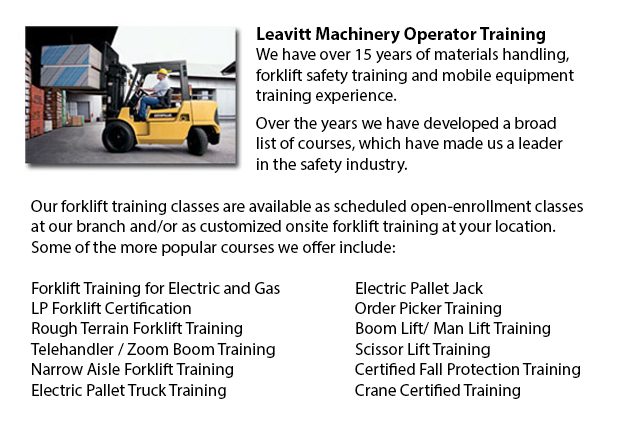
Rough Terrain Forklifts Training Oakville - There are actually two unique categories of forklifts within the material handling market, the industrial model and the rough terrain model. Rough terrain forklifts first arrived on the market in the 1940's and had been primarily utilized on rough roads, perfect for places where no paved surfaces were existing, like building sites and lumberyards.
Usually, the majority of rough terrain lift trucks are run on a propane, diesel or gasoline powered internal combustion engines with a battery used for power. Several makers are playing with rough land lift trucks that consume vegetable matter and run from ethanol. Large pneumatic tires with deep treads typify these vehicles to permit them to clutch onto the roughest soil type without any misstep or shifting.
The initial styles of all terrain forklifts were able to transport weights of up to 1000 lbs, using forks that could run beneath the item, lift it a little bit and then transport it to a different location. After a decade on the market, all terrain lift trucks had been given supplementary hauling strength to about 2000 lbs capacity. Telescoping booms were added in the 1960's, permitting them to stack resources a good deal higher than in earlier years. The telescoping design feature is a staple of nearly all rough terrain lift trucks today. Present styles are capable of managing well over 4000 lbs due to the constant enhancements over the years. Telescoping capability has also improved with some styles reaching a height of 35 feet. Operator safety has also become a focus with many rough terrain lift trucks currently constructed are equipped with an enclosed cab for the driver, versus the older open air seating capacity.
The rough terrain lift trucks on the market today both run well on unpaved roads and paved floors. This kind of all terrain forklift is marketed for its' adaptability enabling the possibility for organizations to utilize one unit to transport resources from an outside working area into a warehouse.
-
Aerial Lifts
Aerial Lift Training Oakville - Aerial hoists can accommodate numerous duties involving high and hard reaching places. Normally utilized to complete routine repair in buildings with lofty ceilings, prune tree branches, raise burdensome shelving units... More -
Pallet Stackers
Pallet Stackers Training Oakville - Pallet stackers are a type of pallet jack that may be utilized to stack, transfer and lift commodities placed on a pallet that are far too tedious for physical lifting. Mainly these mechanisms are used to load and... More -
Boom Trucks
Boom Trucks Training Oakville - A boom truck is frequently recognized by the cable and phone business vehicles that have the extended arm folded over their roofs. Commonly, a bucket-like apparatus sits at the extension of extendable arms. Normally re... More -
Crown Forklift
More -
Reach Trucks
Reach Truck Training Oakville - Reach Trucks are industrialized equipment utilized for loading and storage in some firms that maintain storage of cargo to finished commodities on a pallet which are then inserted into high shelving units. This loading... More

Forklift Certification Oakville
TOLL FREE: 1-888-254-6157
Oakville, Ontario
forkliftcertificationoakville.com
Email Us
About Us


